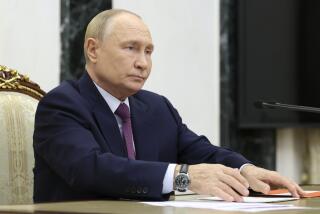Russia a Key in Missile Plan
- Share via
Its empire may be gone and its internal woes may be formidable, but in one respect at least Russia’s claim to superpower status remains strong. It is still, as Harvard’s Celeste A. Wallander notes, “the only country that can destroy the United States in a single large-scale nuclear attack.” Acting President Vladimir V. Putin will zealously guard that power, but at the same time he recognizes Russia’s interest in accepting some rational restraints on its nuclear arsenal. As Putin moves toward his May inauguration as Russia’s second democratically elected president, he is reaffirming his intention to win ratification of START II, the long-pending treaty that would dramatically reduce both the U.S. and Russian nuclear arsenals.
START II is the follow-up to the arms reduction agreement that the United States and the Soviet Union began negotiating in 1982 and finally signed in July 1991. That treaty reduced by 40%, to 1,600, each country’s long-range missile launchers, and by 30%, to 6,000, its warheads. Within 18 months a further agreement was reached, committing both sides to begin further warhead cuts down to a ceiling of about 3,000 each. The Senate ratified START II in 1996, but Russia’s Duma, which until the most recent elections was dominated by Communists and their allies, refused to act. Putin expects greater cooperation from the new and more moderate legislature. A third round of nuclear arms reductions remains a goal.
One impediment to Russian ratification of START II could be Washington’s interest in amending the 1972 Anti-Ballistic Missile Treaty, which sharply restricts the defenses each country can build against nuclear attack. The ABM treaty’s great value is that it allowed a cap to be put on the arms race and assured a rough nuclear balance. With each side limited to a small number of antimissile launchers, the need to keep expanding long-range missile forces to overcome the other side’s defenses ended.
Why does the United States want to tinker with a successful treaty? Because it’s not Russia’s weapons that are now especially feared, but those that might someday be launched by rogue states. Congress and the Clinton administration are looking toward a National Missile Defense system capable of protecting against the relatively small number of missiles a hostile country like North Korea might eventually have. The technology for an effective system has yet to be demonstrated, and decision makers shouldn’t move ahead until it’s clear that a workable system can be built. But if a decision to deploy is made, the ABM treaty will have to be either amended or abrogated.
It should be obvious, as U.S. officials have repeatedly told Moscow, that the National Missile Defense couldn’t defend against a full-scale Russian attack and so is no threat to the nuclear balance. So far, though, Moscow refuses to accept that position. Washington can only keep trying. The United States doesn’t want to lose START II because of Russian antipathy to a new U.S. missile defense. But the nature of the nuclear threat has changed markedly since 1972. American security can’t be put at risk by failing to prepare a defense against a possible limited missile attack from a rogue state.
More to Read
Sign up for Essential California
The most important California stories and recommendations in your inbox every morning.
You may occasionally receive promotional content from the Los Angeles Times.












